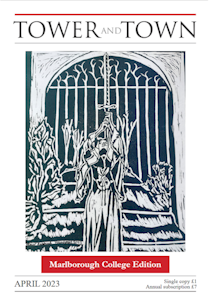

Tower and Town, April 2023 (view the full edition) (view the full edition)Nature Notes: Anticipating AprilAs the first days of Spring slip by in late March, I begin to anticipate April days and all that gradually begins to emerge and flourish in the natural world. In recent years some birds, butterflies and flowers have been appearing earlier than hitherto and things you expect to see in the last days of April arrive a week or so before. I have decided therefore to compile a sort of aide-memoire, listing what to look out for and when, subject to fickle weather. The maximum April day temperature in Wiltshire is 13 degrees, with 14 hours of daylight offering up to 5 hours of sunshine, but we can expect 13 days with some rainfall- 45 mm in total. First Week: If not already seen, Wild Daffodils will still be out, when standard ones are almost past their best. Golden-yellow is a recurring colour with early spring flowers: primroses, lesser celandines, gorse and, amongst my favourites, marsh marigolds, commonly known as "Kingcups", since they resemble the goblet cups of Kings. White and yellow flowers attract insects such as hoverflies and bees to pollinate them. The first Chiff-Chaff begins his stuttering song in our village, while a visit to high ground at Liddington or Cley Hill might offer sight of a migrant Wheatear or Ring Ouzel. Second Week: Brown trout season is underway on the Kennet. With limited flies about, anglers will be using Dark Olives, March Nymphs and Waterhen Spider flies to lure their prey. Riverside walks confirm the arrival of the commoner warblers: Blackcaps, more Chiff-Chaffs and the first Willow Warblers. If the sun is out, the yellow theme continues with Brimstone and pretty Orange Tips butterflies, and there are Peacocks, Red Admirals and the occasional Comma too. Third Week: Make a visit to Clattinger Farm, Cotswold Water Park, to see the Snake's Head Fritillaries, the first Green-winged Orchids and abundant cowslips. The Hirundines will have arrived: first the Sand Martin, then the Swallow and the House Martin, with the Swift yet to appear. Fourth week: Things get hectic! If I know the various setts, earths and ponds, I might watch Badgers and Foxes with cubs in the twilight hours and the male smooth newts, looking superb with big black spots and a wavy crest, performing their courtship dances with the females. Further excitement occurs when I connect with Nightingales, Grasshopper Warblers, both Whitethroat species, plus Sedge and Reed Warblers. To quote Robert Browning: "God's in his heaven, all's right with the world!"  Robin Nelson |